Description and types of carports
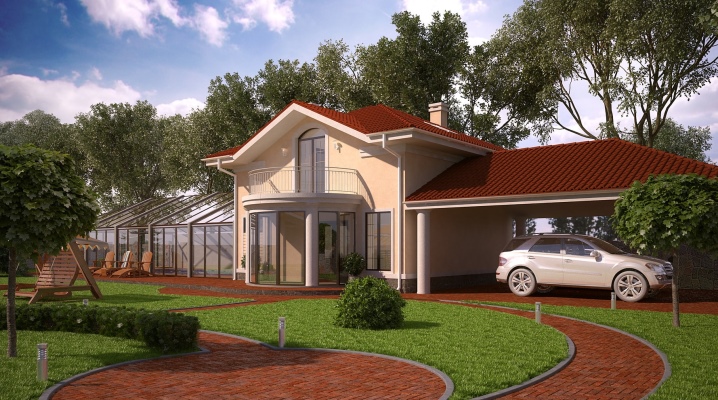
Owners of country houses or summer cottages have to think about where to put the car. The presence of a garage would solve the problem, but building a capital structure is long, expensive and difficult. In addition, it refers to real estate, which means that a permit is required for construction, and then a technical passport and cadastral registration. For a canopy of any complexity, you do not need to do anything of the above, because an easy building has no foundation and main walls, but the owner of the site has the opportunity to overpower the construction on his own.


Peculiarities
Thinking about a protected place for a car, the owners of suburban areas choose between building a garage and a shed. In some cases, a carport is needed as an addition to an existing garage, for example, for a purchased second car. Let's see what the advantages and disadvantages of lightweight buildings are. The advantages include the following points:
- car canopy is able to protect from the sun, rain, hail;
- no special permission is needed for its construction;
- construction without a foundation and main walls will cost several times cheaper and will benefit in the speed of construction;
- most of the construction work can be done independently, which will also help save money;
- during the operation of the canopy, quick access to the car is convenient;
- a beautiful courtyard building can become an effective part of landscape design.
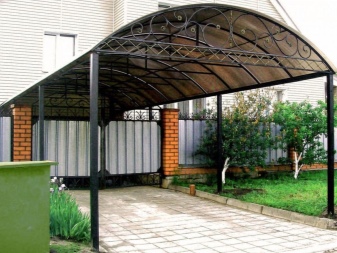
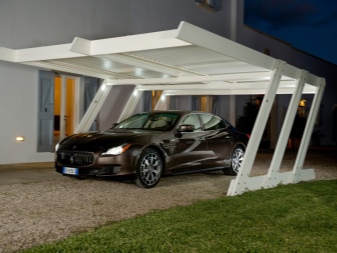
Unfortunately, an open structure also has disadvantages:
- from rain and sun, as well as from theft, it is safer to hide the car in the garage;
- the canopy will not protect from frost at all;
- you can do a full repair of your car only in a garage with a pit, a visor on "legs" cannot provide such an opportunity.
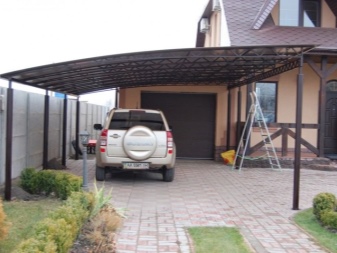

For the construction of a canopy, a place is chosen near the gate. The site is asphalted, concreted or tiled. The truck parking lot is covered with reinforced concrete until the exit. The pillars can be wooden, concrete, brick, stone, metal on a screw connection.
If the aesthetic component of the canopy and its integration into the surrounding landscape are important, it is necessary to draw up a plot diagram, calculate the dimensions of a harmonious building.
The materials and style of the building may match the appearance of the main house and other yard objects.
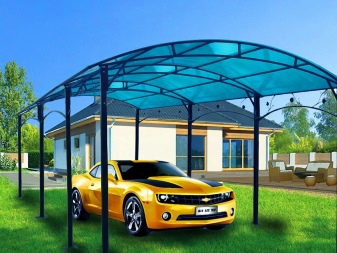
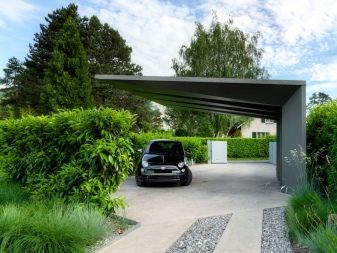
Varieties
The existing varieties of open carports allow the site owner to revise many options and choose a suitable object for his territory. All canopies can be divided according to placement, roof structure, and their mobility.

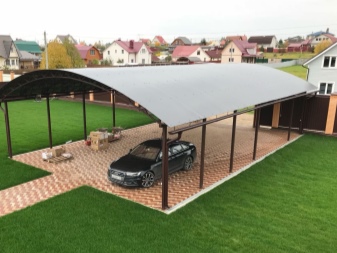
By placement
On the courtyard site, a parking lot is designed in different ways, it all depends on the free space and the project of the house. If the building has not yet been built, you can take advantage of modern developed projects, where the canopy is built together with the house, under one roof or in an ensemble of multi-tiered coverings that make up a common roof. We offer several examples of such structures:
- project of a one-story building with a parking lot under a common roof;
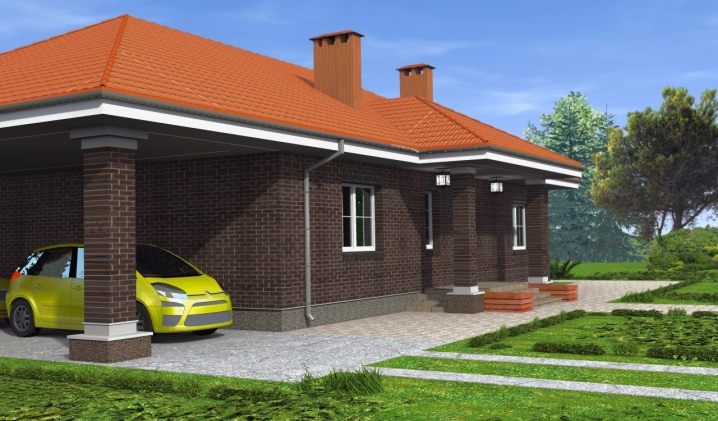
- beautiful exterior of a two-story house with a carport.
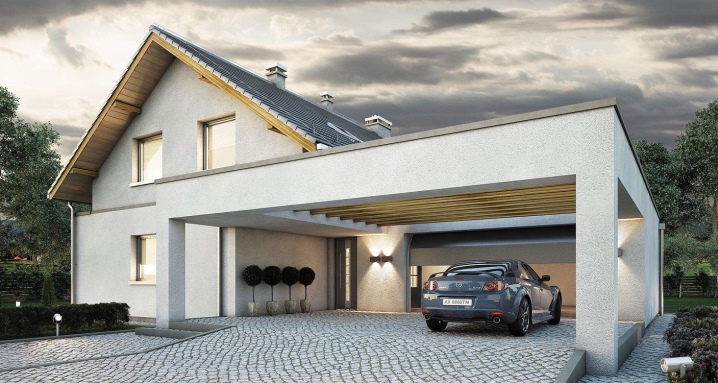
The following types of placement include canopies adjacent to the building, but not under the same roof with it and not related to a single project. Such visors are attached to an already finished house. They are more economical, for their construction it will be necessary to install pillars only on one side, and on the other, the bearing wall of the building takes over the support function.
- Asphalt shingles were used as a covering on the adjacent wooden structure.
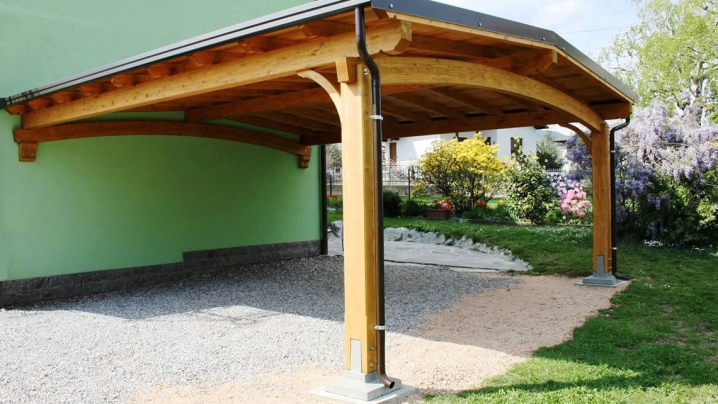
- The canopy, attached between the building and the brick fence, is protected by solid walls on both sides. Polycarbonate was used for the construction of the third wall and roofing.
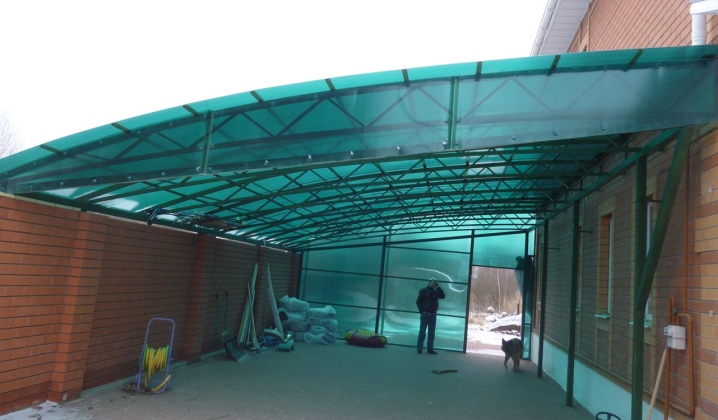
- An independent wooden lean-to canopy that supports one row of powerful supports.
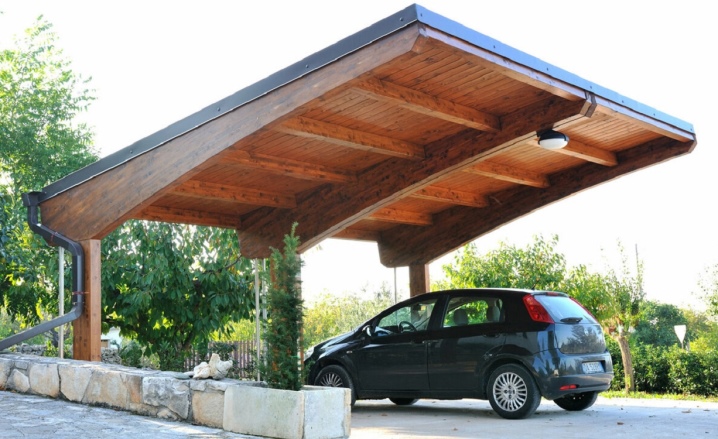
- Compact, separate parking for two cars.
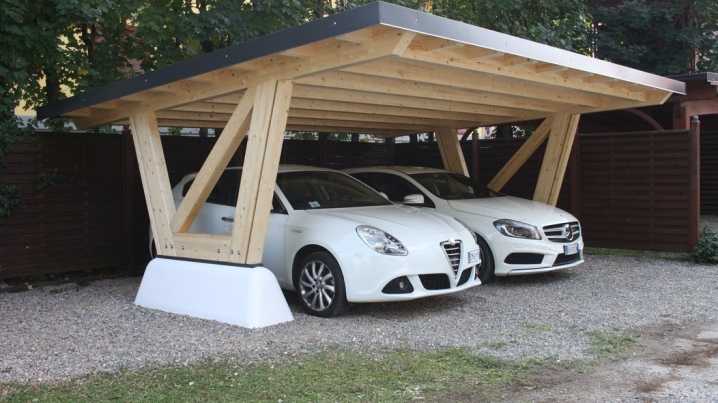
- The structure is assembled from profiled pipes and cellular polycarbonate.
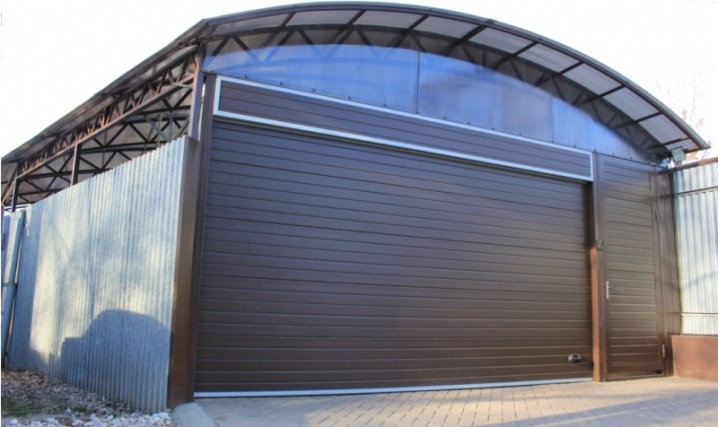
- The canopy covers the entire yard. Through a gate or a wicket, the owner immediately falls under the protection of the roof.
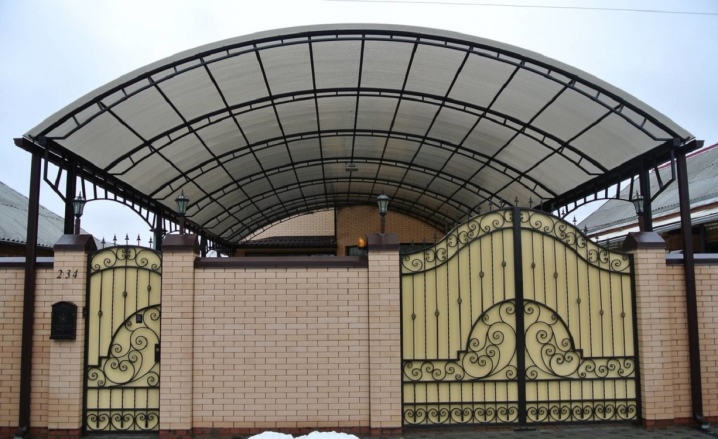
During the construction of sheds, the location of the cars themselves (in a row, one after another), as well as their number, are taken into account.
In the courtyard of a private house, if there is a large territory, several cars can be accommodated at once under one roof. To build a canopy for 3 cars, a reinforced metal frame and lightweight roofing material should be used. We suggest that you familiarize yourself with examples of placing a different number of cars under the visors:
- prefabricated shed for three cars measuring 5x8 m;

- elongated design for two cars with dimensions of 4x8.4 m;
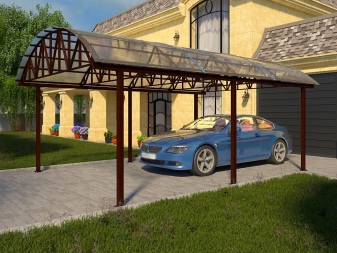
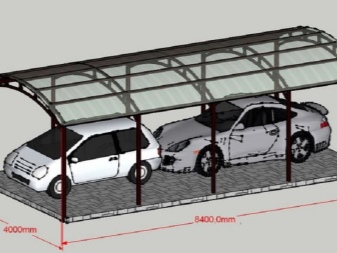
- spacious wooden frame for two cars;

- wall shed for one car with polycarbonate cover.
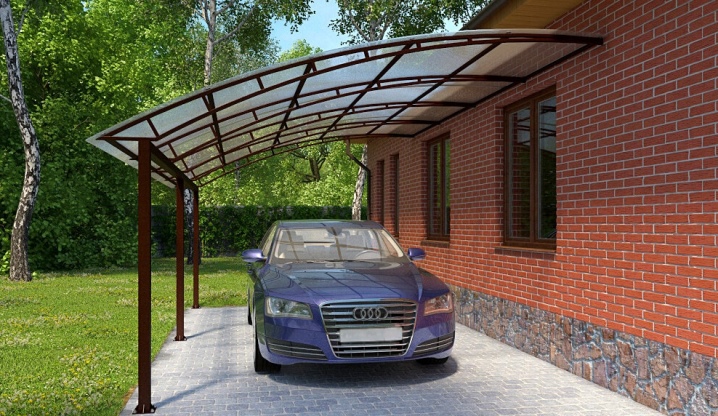
By roof construction
According to the design features of the roof, canopies are divided into single-slope, dual-slope, hip, arched (spherical) and complex.
- Shed. A flat horizontal roof with or without a slope is called a pitched roof. The slope helps precipitation leave the roof quickly. Often this type of awning is attached to the walls of buildings. For the construction of a free-standing structure, one pair of supports is raised 40-50 cm above the second pair in order to obtain the desired slope.

- Gable. The structure consists of two rectangular planes connected at the top and diverging down to the supporting columns. A good two-sided slope of the roof helps to avoid the accumulation of precipitation.
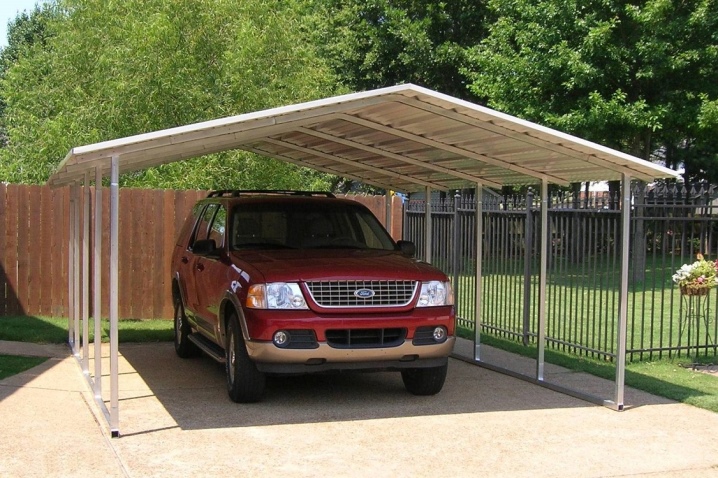
- Hip. The four-pitched canopy roof contains two triangular and two trapezoidal sides. This type of roof is subject to more accurate load calculations, but better than other models it performs protective functions from the wind and allows you to diversify the appearance of the parking lot.
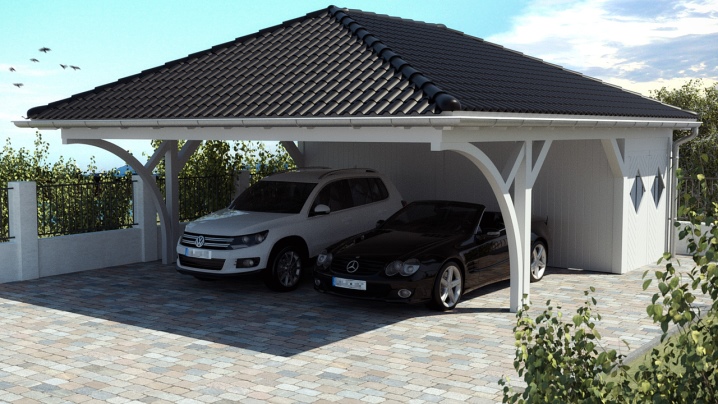
- Arched. The roof is curved in a beautiful semicircle. The ergonomic design protects the machine from slanting precipitation. The aesthetic appearance of the awnings makes it possible to use them in areas with landscape design.

- Difficult. The configuration of complex roof surfaces is also thought out by the landscape designer. Such a canopy should be a decoration of the site and be in harmony with the rest of the buildings in the local area.
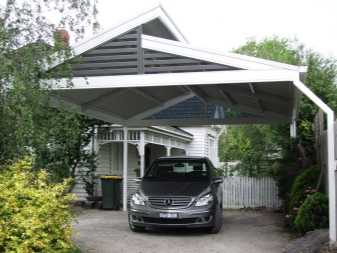
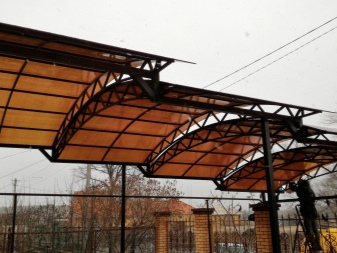
By mobility
Mobile collapsible canopies are needed in several cases:
- if there is not enough space on the personal plot;
- if there is a need to remove the folding canopy at the end of the summer season;
- to operate the model when traveling.
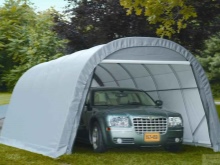
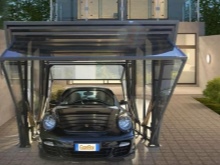
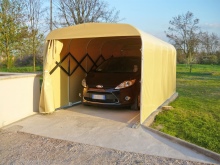
Constructors, designers and just home craftsmen have come up with a great variety of prefabricated products.
Some look more effective, others are easier to understand. We suggest that you familiarize yourself with examples of such structures:
- the elegant model folds down to a minimum base using the control panel;
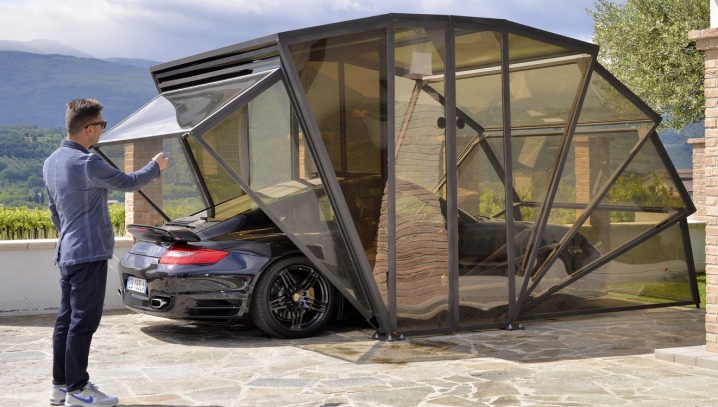
- a similar folding principle (matryoshka) and a fabric canopy, but in this case, the actions are performed manually;
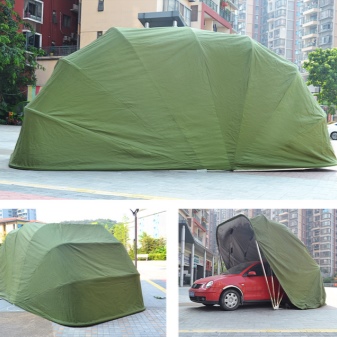
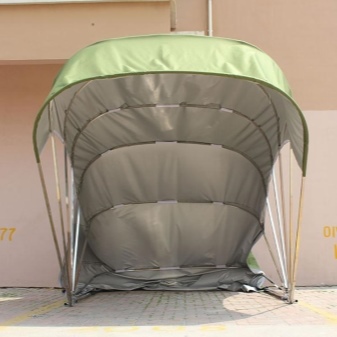
- the quick-folding frame is equipped with a textile cover;
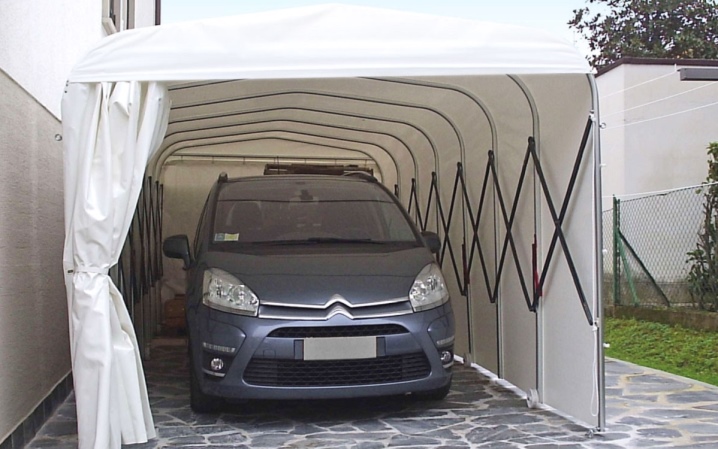
- portable collapsible structures that do not take up much space;
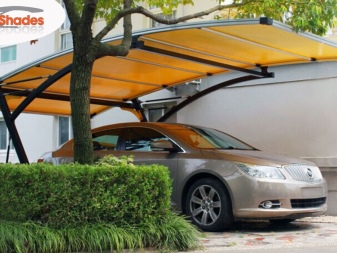
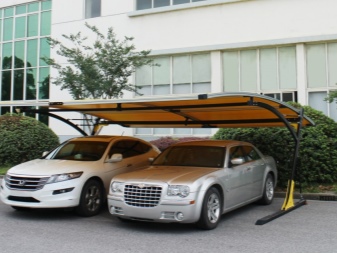
- the mobile canopy can be carried with you everywhere, when assembled it can be placed in the trunk of a car;

- for lovers of travel, a canopy tent, equipped on the upper trunk of the car, was invented;
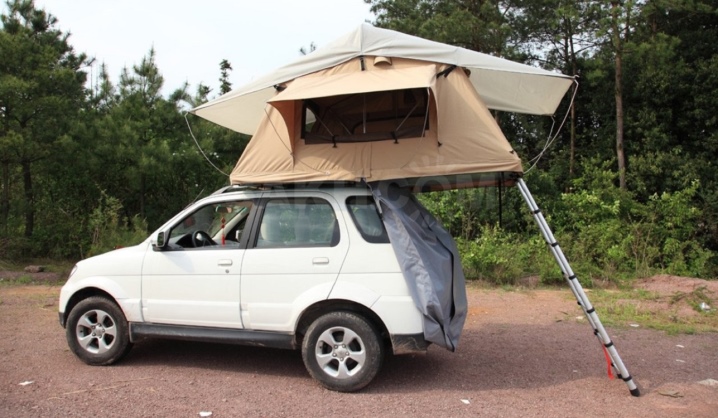
- extravagant summer version of a collapsible visor.
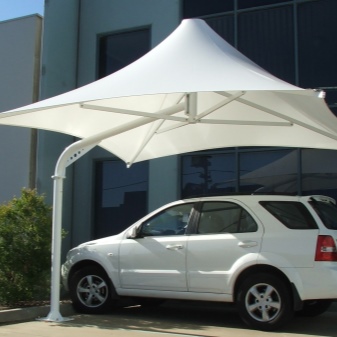
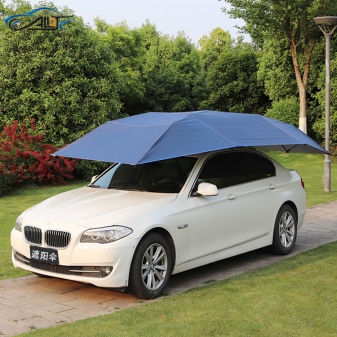
Materials (edit)
In the creation of a canopy, as a rule, the frame and roofing are made of different materials, therefore, we will consider them separately. First, let's figure out what kind of supports are and what frames for visors are erected from.


Brick, stone or concrete
From these types of materials, stationary, strong and durable structures are obtained. But if metal piles just need to be installed, then for brick and stone, a careful calculation of the load and the amount of required building material will be required. Concrete columns need additional finishing. Brick and stone are left unchanged, they look beautiful and high-status, but from time to time they will require some care.
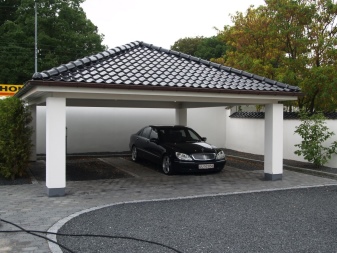
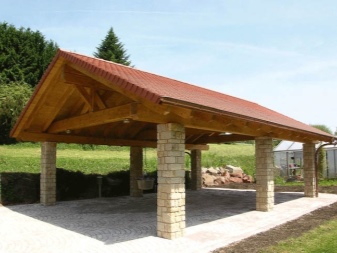
Metal
Metal supports are installed after the foundation is poured, markings are made and holes are drilled with a drill. Then the pillars are mounted, poured with concrete and transferred to the frame structure. To create a frame, profiled pipes are most often used, which are connected to each other by welding. The metal for the supports and the frame must be coated with anti-corrosion compounds.

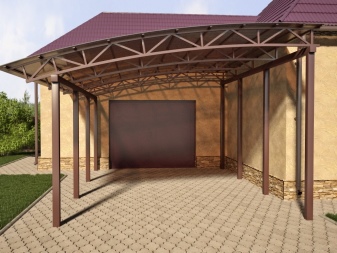
Wood
For those who have experience in joinery and carpentry, it will not be difficult to assemble a frame from wood. From materials and tools, you will need bars and all kinds of hardware to connect them. The wood is treated with antifungal agents. The preparation of the material can take a week, but the assembly process itself takes place during the day. Wooden buildings look organic in suburban areas. In terms of strength, they are inferior to metal and stone products. In dry, hot climates, the pillars can crack over the years. But this does not stop lovers of beautiful natural material from choosing a canopy made of wood.


Any roofing material can be used for the plane of the visor. The canopy will look especially harmonious on the local area if its surface coincides with the roof covering of the main building.
Although this technique is not required, you can pay attention to translucent materials, which simultaneously transmit some of the light and create a shadow.
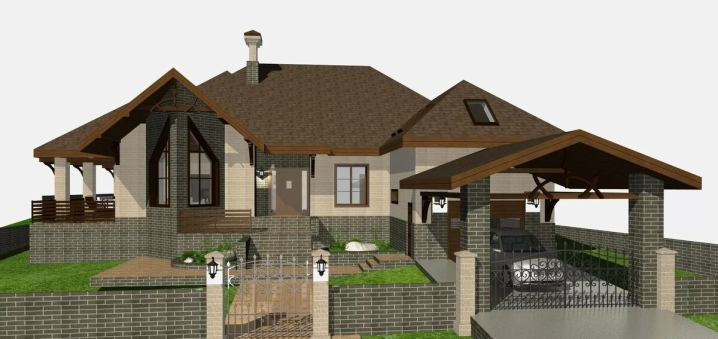
Glass
A glass canopy installed on a frame lathing will not protect from the sun, but it will also prevent rainfall from entering the car. Such material for the visor is rarely used, it is necessary in certain conditions:
- if the canopy is located against the wall of a building with windows, the transparent coating will not prevent daylight from entering the rooms;
- to maintain the overall style of landscape design;
- to create an original modern design.
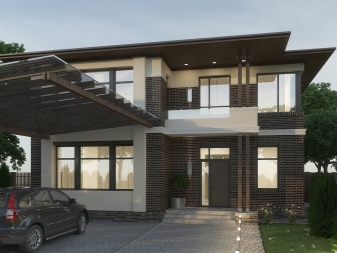
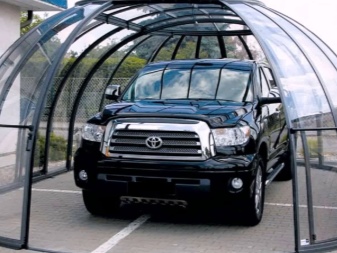
Polycarbonate
This polymer is one of the most popular materials for creating awnings. It can replace glass, not inferior to it in many properties, and sometimes even surpassing it. In terms of strength, polycarbonate is 100 times stronger than glass and 10 times stronger than acrylic. It can withstand temperatures from -45 to + 125 degrees. Monolithic and honeycomb types of this polymer are used to cover the roof.
Externally, monolithic polycarbonate looks like glass, but it is twice lighter. The material transmits up to 90% of the light. Multi-layer color options differ in additional properties: one is more transparent, the other is more durable, and so on. A two-layer monolithic product that does not transmit ultraviolet light is in special demand.
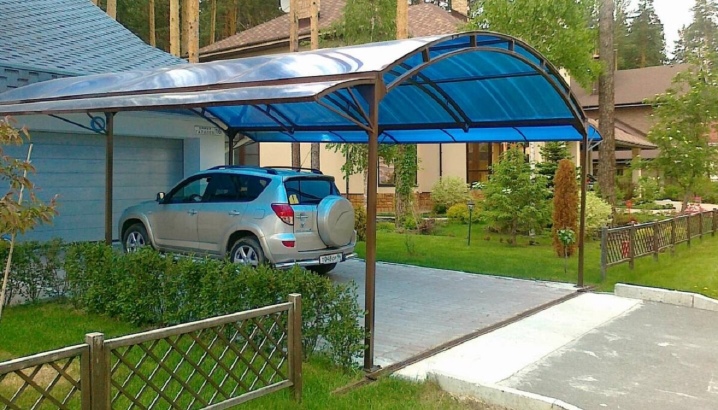
Cellular (structured) polycarbonate consists of multiple bridges connected to each other, placed on the edge. Due to the design features, the sheets look like they are filled with air, they allow it to be flexible and shockproof. This type of polymer is 6 times lighter than glass, is twice as good at stopping sound, and is capable of transmitting light up to 85%.
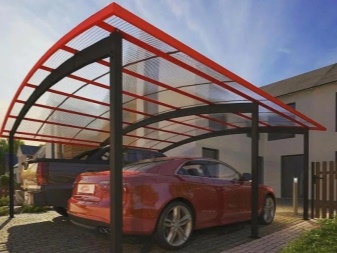
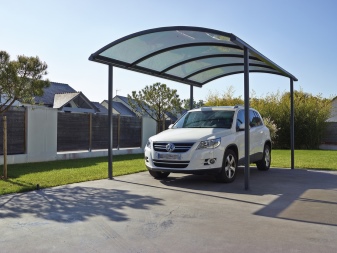
Corrugated board
When choosing a corrugated board, they take into account not only its thickness and strength, but also its aesthetic appearance, waveform, ideality of the edge. Too thick material will increase the load on the supports, which means that you will have to purchase more powerful and expensive stands. The optimum thickness of the canopy roof should be 5 mm.
Careful delivery of the material is necessary; during unsuccessful transportation, it can bend and deform.
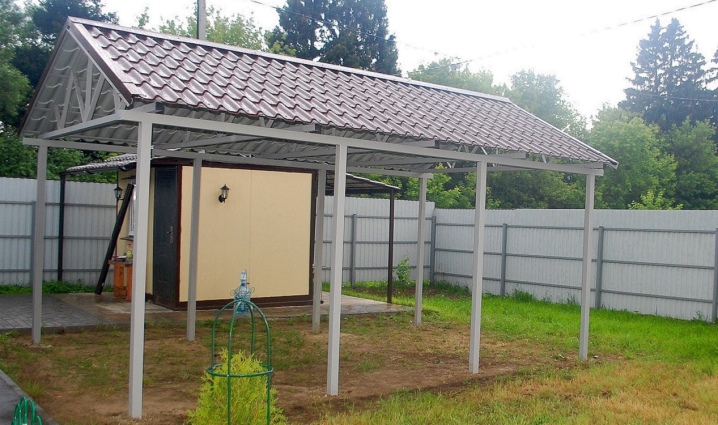
Shingles
To cover the canopy, you can choose ceramic tiles, soft (bituminous) or metal tiles. Each material has its own characteristics.
- Ceramic. It is made of clay, therefore it has a large weight (40-70 kg per sq. M). Supports for the canopy need reinforced, but the roof will last up to 150 years. This is a fireproof eco-friendly material, it is not afraid of frost, does not fade in the sun. The disadvantages include the complexity of installation, high weight and high cost.
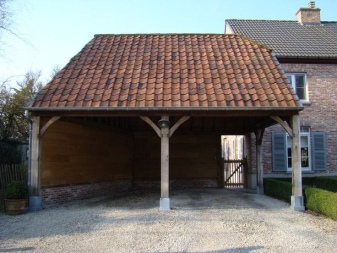
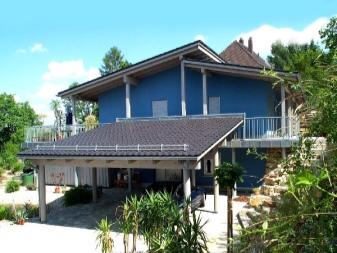
- Metal tiles. It is made from steel roofing sheet, has a low weight - 4-5 kg per sq. m, therefore it is more suitable for creating awnings. It is easy to install, does not burn, withstands severe frosts, and belongs to budget materials. Among the shortcomings, the following can be noted: it gets hot in the sun, makes noise in the rain, accumulates an electric charge, needs a lightning rod.
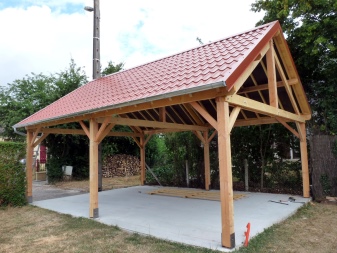
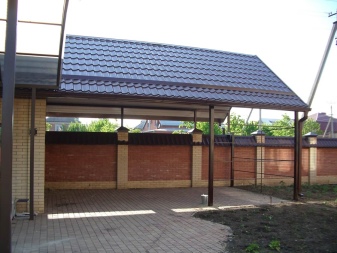
- Bituminous. Refers to a soft roof. It is produced on the basis of bitumen, fiberglass and stone dust. Shingles are made up of small pieces that can always be replaced if they deteriorate over time. It is the compactness of the elements that makes it possible to overcome the roof of any complexity, even the dome. Bituminous shingles are lightweight, do not let water through at all, are easy to install, do not create noise from rain and hail. The cost of this material is higher than metal tiles, but lower than ceramic products. The cost of the roof is made more expensive by plywood sheets, which must be laid out under soft tiles.
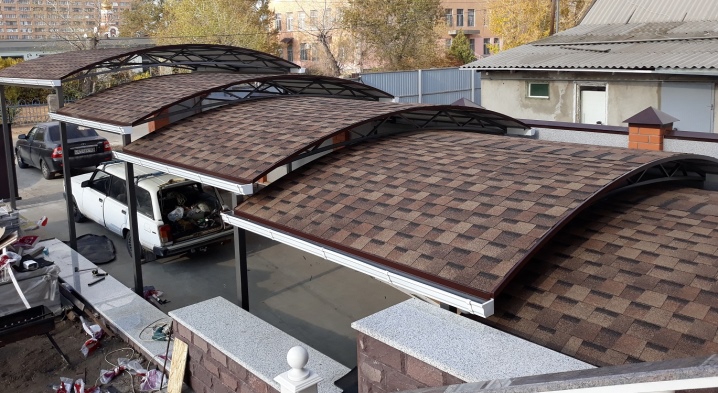
Dimensions (edit)
The minimum parameters of a carport are determined by the dimensions of the car itself, 1-1.5 m of free area are added to them on all sides. With this size, slanting rains can touch the car. The larger the canopy, the easier it is to park. One should not forget about the open doors of the car and the possibility of landing, which is difficult to do in too cramped conditions. The optimum construction height is 2.5 m.
For a large building designed for several cars, the height of the canopy increases in proportion to its massiveness.

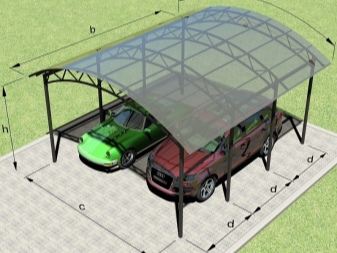
Where to place?
For those who decide to build a canopy on their site, a number of questions arise: at what distance can it be built from the gate and the fence? Is it possible to install above a gas pipe? At the expense of the pipe, the issue is being resolved with the specialists of the local gas service. To correctly calculate and install a canopy on the ground, you need a plot drawing. When choosing a location, you should take into account the optimal approach to the parking lot; it should not block the active pedestrian zone. If there is too little space on the site, the owners go to all sorts of tricks: they start the car under the balcony, arrange underground or two-storey parking lots. We suggest that you familiarize yourself with examples in which places car owners build their sheds:
- a spacious terrace on the second floor level becomes a good cover for a car;
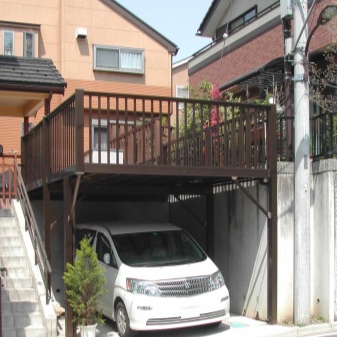

- cars can be integrated into the building, take place under the balcony or under the living room;
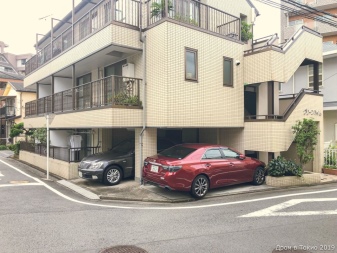
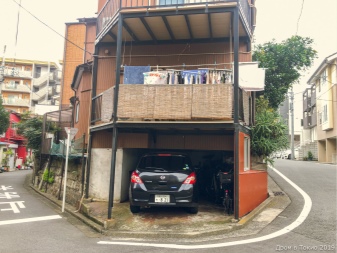
- the car falls under the patronage of the house itself, if you allocate a place for it against the wall and extend the sloping roof of the building to the required size;
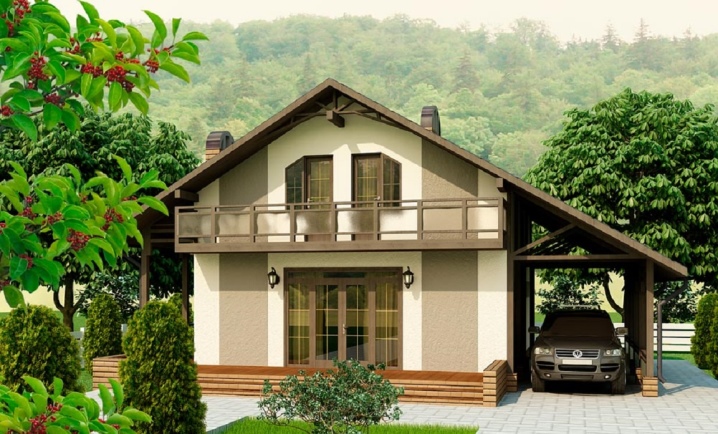
- or you can extend the canopy over the front door so that it can cover the owner's car;
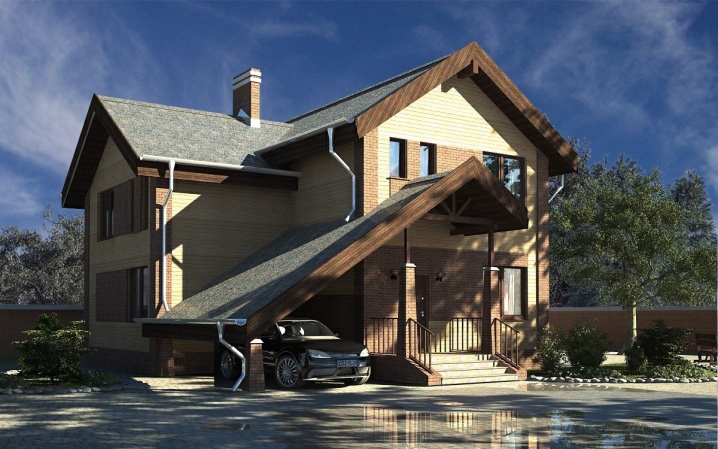
- by connecting lifting mechanisms to the case, you can save space and build an underground parking lot, which becomes a canopy only when raised;


- You can also arrange a parking lot for two cars using a two-storey parking lot with a lifting mechanism.
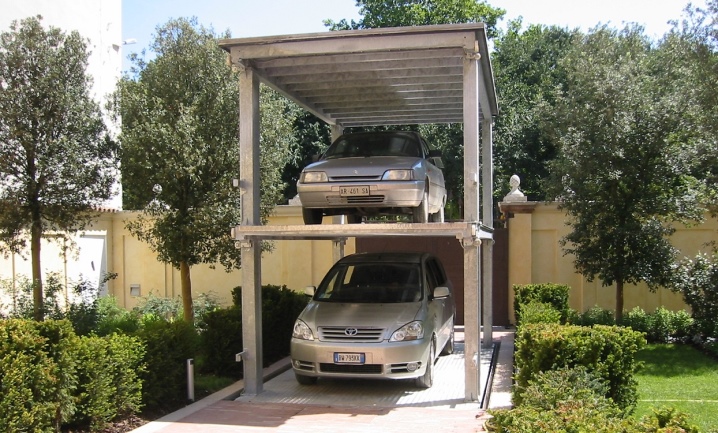
How to do it yourself?
You can make a polycarbonate canopy yourself. We will tell you how to do it.

Frame
Having drawn up a diagram and preparing the site, they make a markup for the supports. Dig holes to a depth of 50-70 cm. The exposed metal supports are checked with a level. The depressions are covered with crushed stone, concreted. After the concrete dries, the top of the supports is strapped with iron beams, and the crossbars are welded to them. At this stage of work, the installation of the drain is carried out.
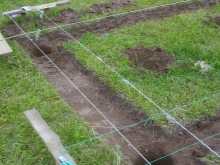
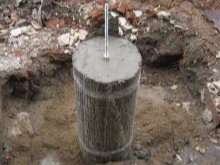
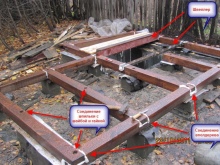
Roof
Polycarbonate is cut according to the project scheme, the sheets are laid out on the frame with the factory film outside and interconnected with special profiles.
To protect the open polycarbonate cells, they are hidden under the end tape, then the protective film is removed from the roof.
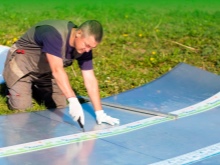
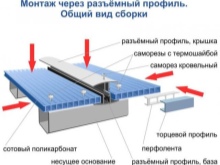

Ready examples
Most private home owners equip their carports with amazing ideas. We offer a selection of beautiful parking lots:
- there was a place for a car under the complex roof of the house;
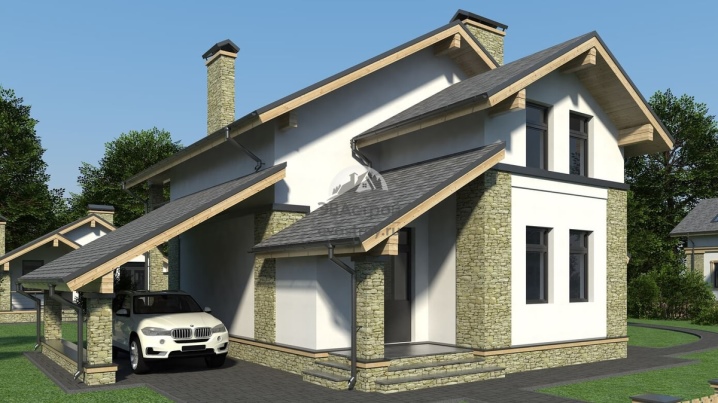
- beautiful modern laconic parking for 2 cars;

- green roof canopy idea;
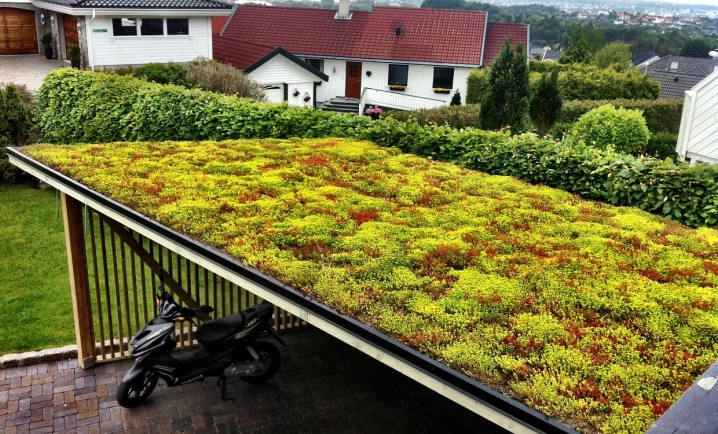
- the visor is made in the same design as the main house;

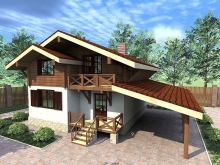
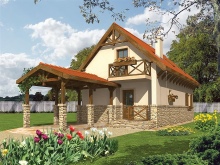
- beautiful wooden canopy - decoration of landscape design.

Well-designed awnings are spectacular and practical; under them you can not only hide the car, but also relax in the fresh air in the shade.
See below for more details.





























































The comment was sent successfully.